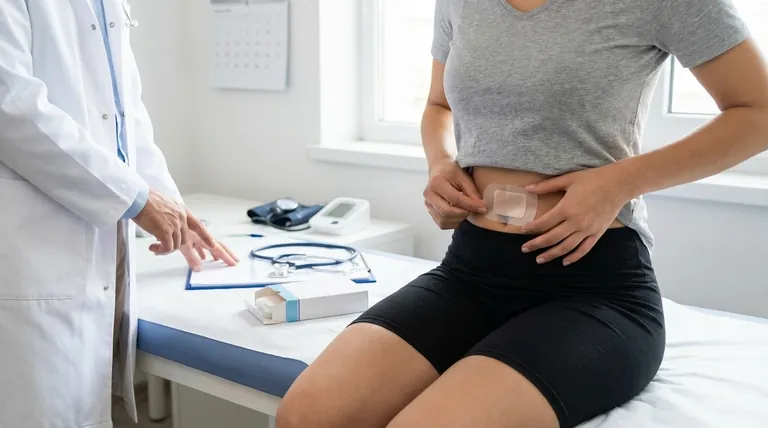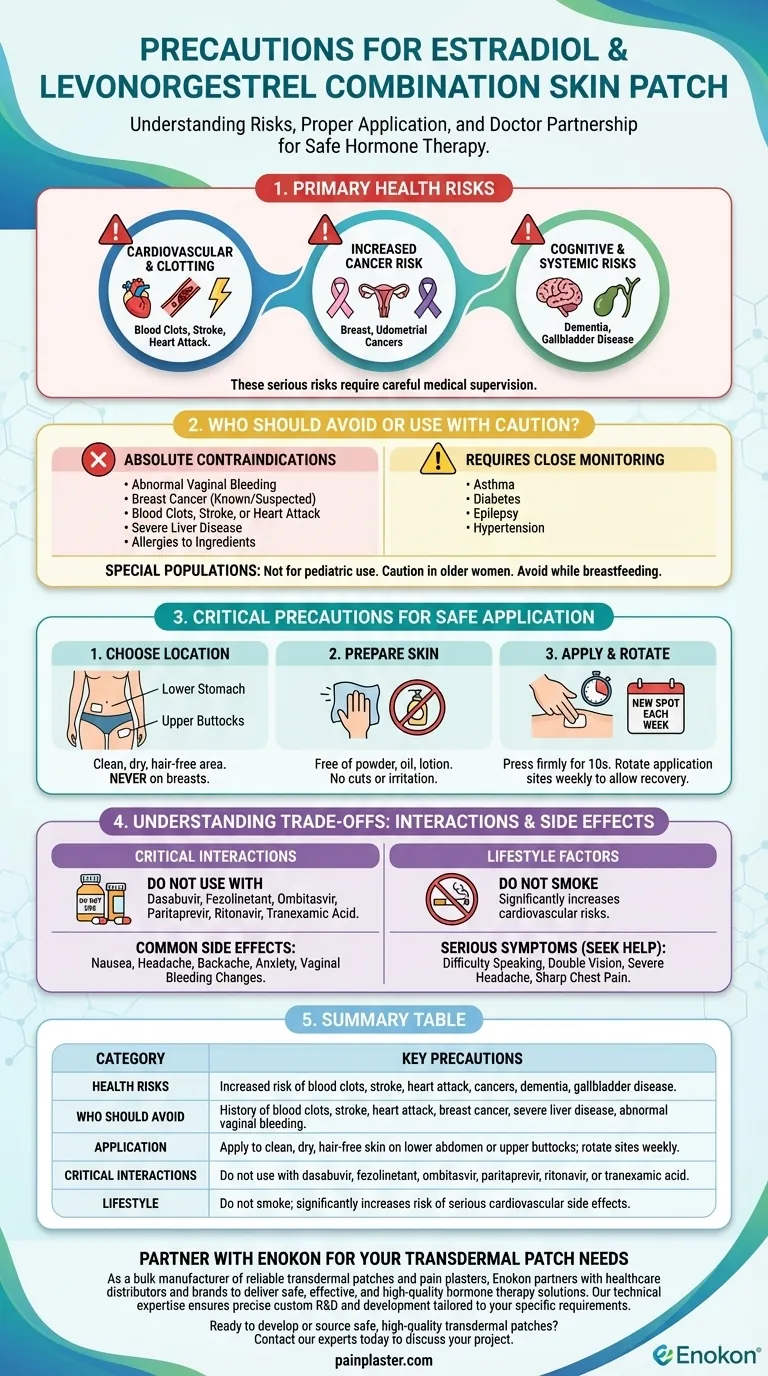When using the estradiol and levonorgestrel combination skin patch, the most critical precautions involve understanding its significant health risks, ensuring proper application, and maintaining transparent communication with your doctor. This medication is not a simple skin treatment; it is a form of hormone therapy that can increase the risk of serious conditions like blood clots, stroke, heart attack, and certain cancers. For this reason, it requires careful medical supervision.
This patch effectively treats menopause symptoms but carries significant health risks. Safe use is not just about applying the patch correctly—it's about a continuous partnership with your healthcare provider to monitor your health, manage potential side effects, and ensure the benefits continue to outweigh the risks for you.

Understanding the Primary Health Risks
Using this patch requires weighing its benefits against a known increase in risk for several serious health conditions. This is the most important conversation to have with your doctor.
Cardiovascular and Clotting Risks
Hormone therapy can affect your circulatory system. The patch is known to increase the risk of developing blood clots, which can lead to a stroke or heart attack.
Increased Cancer Risk
Long-term use of estrogen-containing products has been linked to an increased risk of developing breast cancer, endometrial cancer, and uterine cancer. Regular screenings and check-ups are essential.
Cognitive and Other Systemic Risks
Studies have shown a potential link between hormone therapy and an increased risk of dementia in postmenopausal women. There is also a heightened risk of developing gallbladder disease.
Who Should Avoid or Use This Patch with Caution?
Your personal and family medical history directly impacts whether this patch is a safe option for you. Certain pre-existing conditions are absolute contraindications, while others simply require closer monitoring.
Absolute Contraindications
You should not use this patch if you have a history of:
- Abnormal or undiagnosed vaginal bleeding
- Known or suspected breast cancer
- Blood clots, stroke, or heart attack
- Severe liver disease
- Allergies to estradiol or levonorgestrel
Conditions Requiring Close Monitoring
If you have conditions like asthma, diabetes, epilepsy, or hypertension, using this patch may worsen them. Your doctor will need to monitor you more closely to manage your health.
Special Populations
The patch is not indicated for pediatric use. For older women, its use requires caution due to the increased risks of breast cancer, stroke, and dementia. It should not be used while breastfeeding due to potential risks to the infant.
Critical Precautions for Safe Application
How and where you apply the patch is crucial for its effectiveness and for avoiding skin irritation.
Choosing the Right Location
Apply the patch to a clean, dry, and hair-free area of skin on the lower stomach (abdomen) or upper buttocks. Never apply it to your breasts.
Preparing the Skin
The application site must be free of any powder, oil, or lotion, as these can prevent the patch from sticking properly. Do not apply it to skin that has cuts, scrapes, burns, or any existing irritation or skin condition.
The Application Process
Press the patch firmly in place with the palm of your hand for about 10 seconds. Always apply a new patch to a different spot each week to allow your skin to recover. This is called rotating application sites.
Understanding the Trade-offs: Interactions and Side Effects
Like any medication, the patch can interact with other drugs and cause side effects. Awareness is key to managing them.
Critical Drug Interactions
This patch should never be used with certain medications, including dasabuvir, fezolinetant, ombitasvir, paritaprevir, ritonavir, or tranexamic acid. It is vital to tell your doctor about every prescription, over-the-counter drug, and supplement you take.
Lifestyle Factors
Do not smoke while using this patch. Smoking significantly increases the risk of serious cardiovascular side effects like blood clots and heart attacks.
Common Side Effects to Monitor
Be aware of potential side effects such as nausea, headache, backache, anxiety, or changes in vaginal bleeding patterns. Discuss any persistent or bothersome side effects with your doctor.
Serious Symptoms Requiring Immediate Attention
Seek immediate medical help if you experience signs of a serious problem, such as difficulty speaking, double vision, a sudden severe headache, or sharp chest pain.
Making the Right Choice for Your Health
Your approach to using this patch should be proactive and informed. Partner with your doctor to navigate the decision-making and treatment process safely.
- If your primary concern is safety: Your top priority is a thorough discussion with your doctor about your personal and family medical history before starting.
- If you are already using the patch: The most important action is to apply it exactly as directed, rotate sites, and never miss a follow-up appointment.
- If you take other medications: You must provide your doctor with a complete list of all prescriptions, over-the-counter drugs, and supplements to avoid dangerous interactions.
Proactive communication with your healthcare provider is the cornerstone of using this medication safely and effectively.
Summary Table:
| Category | Key Precautions |
|---|---|
| Health Risks | Increased risk of blood clots, stroke, heart attack, breast/uterine cancer, dementia, gallbladder disease. |
| Who Should Avoid | History of blood clots, stroke, heart attack, breast cancer, severe liver disease, abnormal vaginal bleeding. |
| Application | Apply to clean, dry, hair-free skin on lower abdomen or upper buttocks; rotate sites weekly. |
| Critical Interactions | Do not use with dasabuvir, fezolinetant, ombitasvir, paritaprevir, ritonavir, or tranexamic acid. |
| Lifestyle | Do not smoke; significantly increases risk of serious cardiovascular side effects. |
Partner with Enokon for Your Transdermal Patch Needs
As a bulk manufacturer of reliable transdermal patches and pain plasters, Enokon partners with healthcare and pharmaceutical distributors and brands to deliver safe, effective, and high-quality hormone therapy solutions. Our technical expertise ensures precise custom R&D and development tailored to your specific requirements, helping you bring trusted products to market with confidence.
Ready to develop or source safe, high-quality transdermal patches? Contact our experts today to discuss your project and benefit from our manufacturing excellence.
Visual Guide

Related Products
- Capsaicin Chili Medicated Pain Relief Patches
- Far Infrared Deep Heat Relief Patches Medicated Pain Relief Patches
- Heating Pain Relief Patches for Menstrual Cramps
- Asthma Cough and Pain Relief Patch for Adults and Kids
- Far Infrared Pain Patch Relief Pain Reliever for Back
People Also Ask
- Are natural and herbal pain relief patches effective and safe? Discover the Benefits of Targeted Relief
- Can the pain relief patch be used with other external analgesic products? A Critical Safety Guide
- Can children use the pain relief patch? A Critical Safety Guide for Parents
- How do pain relief patches work? A Guide to Targeted, Long-Lasting Pain Relief
- What precautions should be taken with buprenorphine patches? Ensure Safe Use and Avoid Overdose Risks













